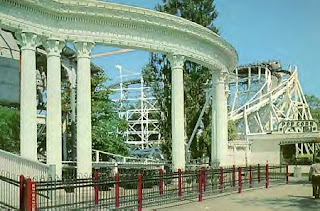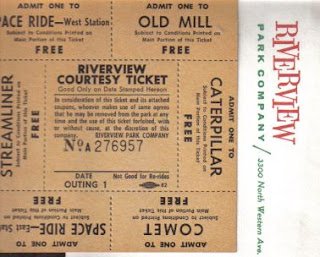Riverview Park: Its Role in a Changing Metropolitan Area
U.S. History June 4, 1999
.jpg/800px-Entrance_to_Riverview_Park_(JJH).jpg) The 74 acres bordered by Western and Belmont avenues, the Chicago River, and Lane Tech High School were known affectionately as "Riverview" to at least three generations of Chicagoans from as early as 1904 to as recent as 1967. Riverview Amusement Park was (sometimes disputably) billed as "The World’s Largest Amusement Park" throughout its 64-year popularity. For some people a trip to Riverview was a rite of passage; for others, it was a familiar weekend excursion, but for most people who went there, a trip to Riverview was a significant memory not soon forgotten. As Chicago natives, my parents and my grandparents can attest to the significance of Riverview. My grandmother’s eighth grade graduation trip was to Riverview, and she has fond memories of the four summers she spent as a cotton candy vendor there. My parents also have vivid memories of trips to Riverview. The story of Riverview Amusement Park is one remembered by many.
 German Sharpshooter Park, as the area that would become Riverview was known as during the late 1800’s, was a shooting range and picnic grounds owned by the wealthy Schmidt family. Wilhelm Schmidt later put in swings and some rides for the ladies and children and Riverview was born. Soon after its opening in 1904, Wilhelm’s son George began to expand the park with ideas he had picked up in Europe from parks such as Tivoli Gardens. One of these ideas was Riverview’s famous 70-horse carousel, commissioned from a group of Swiss-Italian carvers employed by the Philadelphia Toboggan Company and installed in 1908. Riverview’s popularity grew during the early 1900’s as a ballroom and a roller rink were built for entertainment during the winter season. The Riverview Boosters Club, started in 1919, sponsored events such as an Armistice Day Party and membership drives throughout the early twenties. German Sharpshooter Park, as the area that would become Riverview was known as during the late 1800’s, was a shooting range and picnic grounds owned by the wealthy Schmidt family. Wilhelm Schmidt later put in swings and some rides for the ladies and children and Riverview was born. Soon after its opening in 1904, Wilhelm’s son George began to expand the park with ideas he had picked up in Europe from parks such as Tivoli Gardens. One of these ideas was Riverview’s famous 70-horse carousel, commissioned from a group of Swiss-Italian carvers employed by the Philadelphia Toboggan Company and installed in 1908. Riverview’s popularity grew during the early 1900’s as a ballroom and a roller rink were built for entertainment during the winter season. The Riverview Boosters Club, started in 1919, sponsored events such as an Armistice Day Party and membership drives throughout the early twenties.
The "roaring" attitude of the twenties had its effects on Riverview, as well. During Prohibition, the many beer-drinking German patrons of Riverview found the park’s picnic grounds continuing to flow freely with beer, even with some interruptions from federal agents. Chicago political machines also made good use of the popularity of Riverview during the 1920’s. Mayor "Big Bill" Thompson sponsored free childrens’ days at Riverview and paid the Western Ave. streetcar fare during the summer. "The park also became a focal point for the developing rivalry between the O’Bannion and Capone gangs," states Al Griffin in Chicago History. Riverview became even more "roaring" in 1926 with the addition of "The Bobs" roller coaster. "The Bobs" was an 11-car coaster with an 85-foot drop, long billed as the most fearsome roller coaster in the country, as well as the fastest on record. Built at the gargantuan (for the 1920’s) cost of 80,000 dollars, "The Bobs" carried 1,200 passengers per hour and drew some 700,000 riders each season. "The Bobs" remained uncontestedly the most popular ride at Riverview throughout its existence.
The Great Depression of the 1930’s hit Riverview hard, as it did most entertainment industries. During the early 1930’s a devastating fire burned down one of the earlier fun houses, called the Bug House, and sections of the Derby Racing Coaster. Even without excess cash flow, Chicagoans continued to find ways to go to Riverview as is evidenced by George Schmidt’s introduction of the foot-long hot dog during the thirties. Most visitors to Riverview opted to eat at the Bowery rather than in the restaurants during the Depression years, so Schmidt began selling the foot-long as something filling yet inexpensive. It’s easy to see why Riverview’s motto became "Laugh Your Troubles Away."
The years during World War II brought more changes to Riverview. The American National Socialist Party held its annual picnic and rally at Riverview in 1939. Thousands of Nazis postured and marched and hailed Hitler on the amusement park grounds. In contrast to this, Riverview became a popular place for returning servicemen and began to thrive again after the lag during the thirties. The postwar baby boom of the late 1940’s and 1950’s brought greatly increased prosperity to Riverview. "In the old days we’d have families of only one or two children. Now they come with four or five or more," stated G.G. Botts, Riverview vice president, of the baby boom’s effects. During the fifties, one couple that met at Riverview insisted on being married on the Pair-o-Chutes ride, and even found a minister to do it. The downside to this increased popularity was the rise of other amusement parks that presented stiff competition for Riverview. In 1948 there were only 420 amusement parks nationwide; in 1958 the number had grown to over 700.
 The movement of more and more African Americans to Chicago heightened racial tension at Riverview during that time period, as well. One of the midway games that started out as a "Dunk the Bozo the Clown" game in which contestants threw balls at a target that would release a man into a tank of water turned into "Dunk the Nig**r" during the 1940’s. African American men were hired to sit in the tanks and taunt white passersby, who often would throw the balls at the African American in the tank rather than at the target. The title of the game was later changed to the more politically correct "African Dip" and was eventually closed by Schmidt in the late 1950’s after much pressure from the NAACP. By the time the game closed, "the men who lost their jobs were reportedly making over three hundred dollars a week in what was considered to be the highest-grossing concession in Riverview’s history." The game left a lasting effect, as well. It allowed ethnically diverse Chicagoans to define themselves as "white" and to develop a sense of racial solidarity that "obscured the particulars of their own ethnic backgrounds." This development served to further segregate the city. Fights sprang up more frequently at Riverview after this, and by the 1960’s Riverview required its own police force.
The movement of more and more African Americans to Chicago heightened racial tension at Riverview during that time period, as well. One of the midway games that started out as a "Dunk the Bozo the Clown" game in which contestants threw balls at a target that would release a man into a tank of water turned into "Dunk the Nig**r" during the 1940’s. African American men were hired to sit in the tanks and taunt white passersby, who often would throw the balls at the African American in the tank rather than at the target. The title of the game was later changed to the more politically correct "African Dip" and was eventually closed by Schmidt in the late 1950’s after much pressure from the NAACP. By the time the game closed, "the men who lost their jobs were reportedly making over three hundred dollars a week in what was considered to be the highest-grossing concession in Riverview’s history." The game left a lasting effect, as well. It allowed ethnically diverse Chicagoans to define themselves as "white" and to develop a sense of racial solidarity that "obscured the particulars of their own ethnic backgrounds." This development served to further segregate the city. Fights sprang up more frequently at Riverview after this, and by the 1960’s Riverview required its own police force.The closing of Riverview at the end of the 1967 season was a shock to many people. As Riverview was still bringing in 65,000 dollars on a good day, it seemed hard for people to attribute the end to economic reasons. But in truth, the Schmidts were probably offered a deal that they couldn’t pass up. They had installed a Disney-esque Space Ride in 1963 that cost 375,000 dollars and was reportedly losing money. Also, real estate prices in that downtown area were rising rapidly and the union labor and private police and fire departments, not to mention yearly repairs on the aging rides, cost the park more and more money. For whatever reason, the park was purchased by a LaSalle Street investment firm on October 3, 1967 for an estimated 6.5 million dollars and promptly demolished. Only the Merry-go-Round and several smaller souvenirs were saved. After storage in Galena, Illinois, the Merry-go-Round was purchased in 1971 and is now in Atlanta at Six Flags Over Georgia. The distortion mirrors from Aladdin’s Castle fun house are reportedly at a dance club in Palatine. The area that was once Riverview is now home to a DeVry Institute of Technology, a police station, and a shopping center.
There were many inside facts about Riverview that employees learned while working there. My grandmother, who sold cotton candy there as a teenager, remembers a lot about the park that the average visitor never found out. For instance, the park hired plants to walk around the midway with prizes, enticing people to play the games. Employees got to take the pre-opening test rides and enjoyed such thrills as the Bobs and the Chute-the-Chutes for free. Also, Riverview didn’t have a set closing time, but depended on the flow of the crowd to tell them when to close. Vendors on the midway watched for the lights of the Hades fun house to go out to know when to start shutting down.

Riverview Amusement Park had a lasting impact on the city of Chicago. Most importantly, it allowed people of different ethnic, racial, and socioeconomic backgrounds to interact with each other in an otherwise ethnically segregated city. During its 64 years in existence it was said to entertain over 200,000,000 people. It played important roles during Prohibition, the Depression, World War II, and the baby boom of the fifties and sixties. Helen FitzMaurice says in The Chicago Tribune, "Riverview, like a fading Viennese beauty, held on to her air of old world charm, even when time and the electronic age so ruthlessly forced their way upon her. I am glad that those who were responsible retired her before every vestige of her charm was gone." Even if Riverview and its impact are sorely missed by Chicagoans, its closing was sadly appropriate. In the age of "The Raging Bull" and "The Viper," "The Bobs" and "The Chute-the-Chutes" would seem out of place and belonging to another age. As society looks for more daring risks, technology must follow. Despite being in the shadow of the increasingly technological aspects of today’s amusement park entertainment, Riverview will stand out in many peoples’ memories for the good times they had there and in Chicago’s history for its important social impact on the city.
|















![]()
.jpg/800px-Entrance_to_Riverview_Park_(JJH).jpg)





You need to be a member of I Grew Up In Chicago to add comments!
Join I Grew Up In Chicago